HC1052 - Organizational Behavior: Critique of Motivation Article
VerifiedAdded on 2023/06/11
|6
|1400
|373
Essay
AI Summary
This essay presents a critical analysis of an article discussing the role of motivation techniques in enhancing organizational performance and employee productivity. The critique identifies the article's thesis, which centers on the impact of motivational strategies on employee efficiency, particularly through wages and a conducive work environment. The analysis highlights the strengths of the thesis, such as its emphasis on management's role in improving employee relations and satisfaction. However, it also points out weaknesses, including the lack of focus on productivity as an end result and the overemphasis on wages as a primary motivator. The author's personal opinion is that motivation stems from recognizing employee needs through rewards and appreciation, and that the article fails to adequately address the behavioral changes resulting from motivational strategies. The critique concludes by arguing that while motivation is important, efficiency is more directly tied to effective management strategies and a supportive work environment, rather than solely relying on the motivation techniques discussed in the original article. The student provides references to support their arguments.
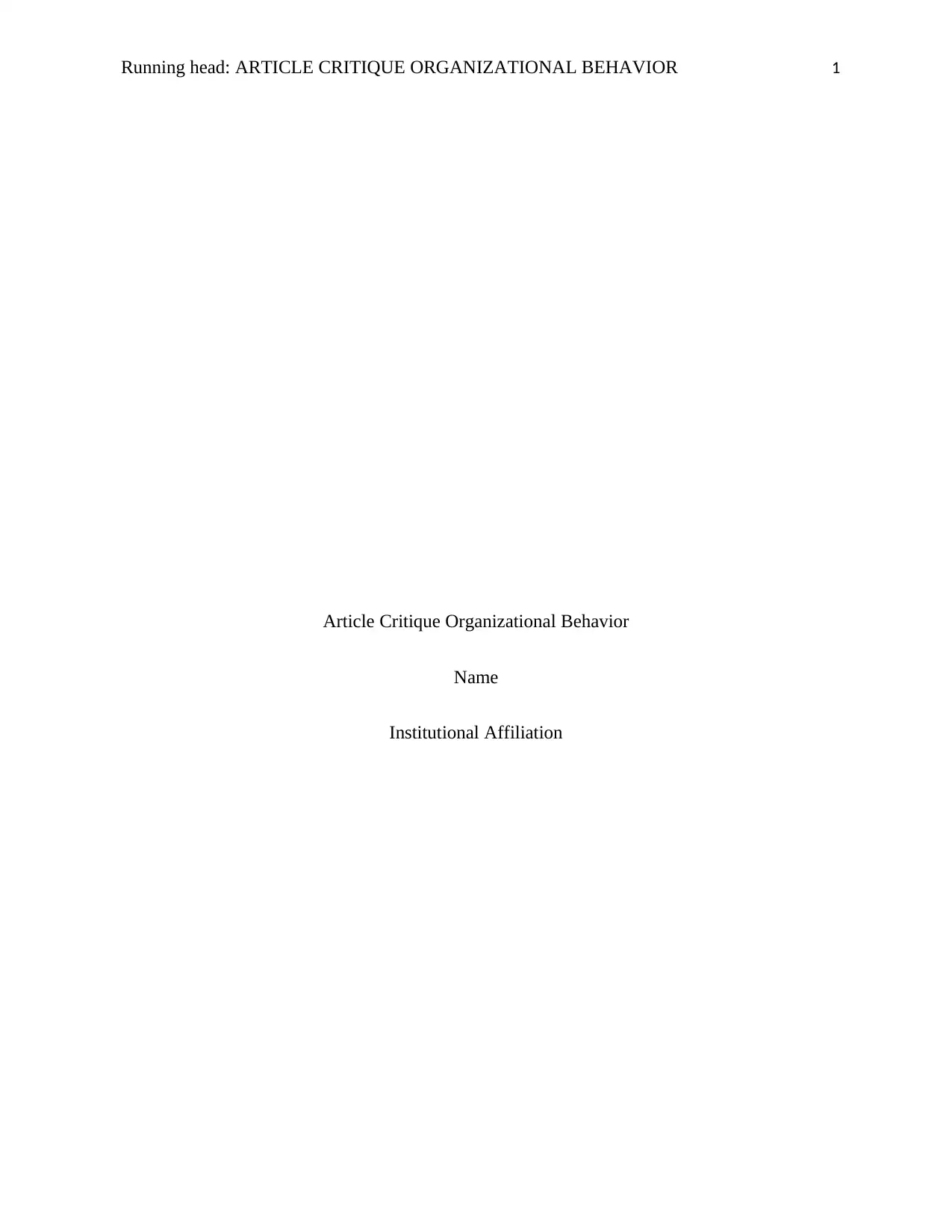
Running head: ARTICLE CRITIQUE ORGANIZATIONAL BEHAVIOR 1
Article Critique Organizational Behavior
Name
Institutional Affiliation
Article Critique Organizational Behavior
Name
Institutional Affiliation
Paraphrase This Document
Need a fresh take? Get an instant paraphrase of this document with our AI Paraphraser
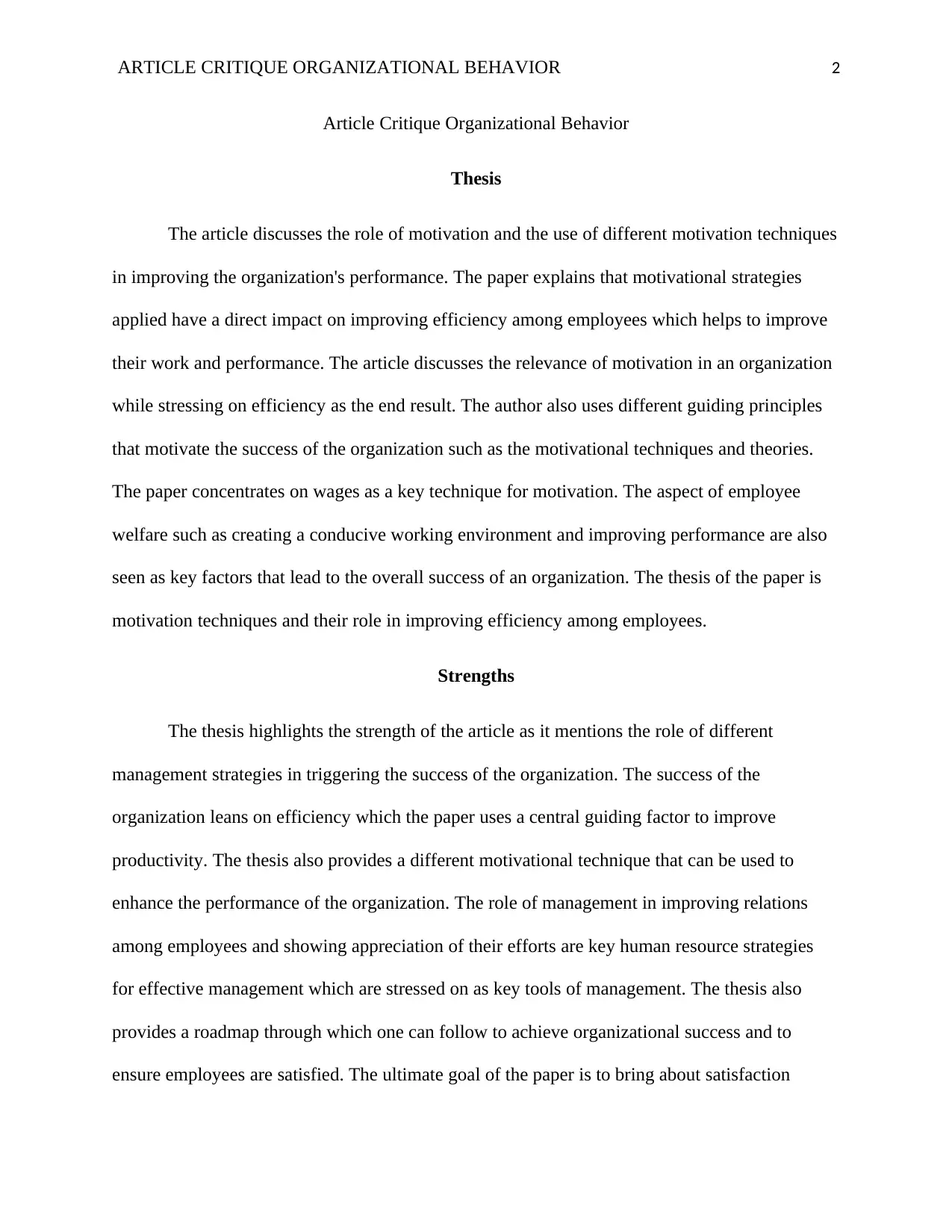
ARTICLE CRITIQUE ORGANIZATIONAL BEHAVIOR 2
Article Critique Organizational Behavior
Thesis
The article discusses the role of motivation and the use of different motivation techniques
in improving the organization's performance. The paper explains that motivational strategies
applied have a direct impact on improving efficiency among employees which helps to improve
their work and performance. The article discusses the relevance of motivation in an organization
while stressing on efficiency as the end result. The author also uses different guiding principles
that motivate the success of the organization such as the motivational techniques and theories.
The paper concentrates on wages as a key technique for motivation. The aspect of employee
welfare such as creating a conducive working environment and improving performance are also
seen as key factors that lead to the overall success of an organization. The thesis of the paper is
motivation techniques and their role in improving efficiency among employees.
Strengths
The thesis highlights the strength of the article as it mentions the role of different
management strategies in triggering the success of the organization. The success of the
organization leans on efficiency which the paper uses a central guiding factor to improve
productivity. The thesis also provides a different motivational technique that can be used to
enhance the performance of the organization. The role of management in improving relations
among employees and showing appreciation of their efforts are key human resource strategies
for effective management which are stressed on as key tools of management. The thesis also
provides a roadmap through which one can follow to achieve organizational success and to
ensure employees are satisfied. The ultimate goal of the paper is to bring about satisfaction
Article Critique Organizational Behavior
Thesis
The article discusses the role of motivation and the use of different motivation techniques
in improving the organization's performance. The paper explains that motivational strategies
applied have a direct impact on improving efficiency among employees which helps to improve
their work and performance. The article discusses the relevance of motivation in an organization
while stressing on efficiency as the end result. The author also uses different guiding principles
that motivate the success of the organization such as the motivational techniques and theories.
The paper concentrates on wages as a key technique for motivation. The aspect of employee
welfare such as creating a conducive working environment and improving performance are also
seen as key factors that lead to the overall success of an organization. The thesis of the paper is
motivation techniques and their role in improving efficiency among employees.
Strengths
The thesis highlights the strength of the article as it mentions the role of different
management strategies in triggering the success of the organization. The success of the
organization leans on efficiency which the paper uses a central guiding factor to improve
productivity. The thesis also provides a different motivational technique that can be used to
enhance the performance of the organization. The role of management in improving relations
among employees and showing appreciation of their efforts are key human resource strategies
for effective management which are stressed on as key tools of management. The thesis also
provides a roadmap through which one can follow to achieve organizational success and to
ensure employees are satisfied. The ultimate goal of the paper is to bring about satisfaction
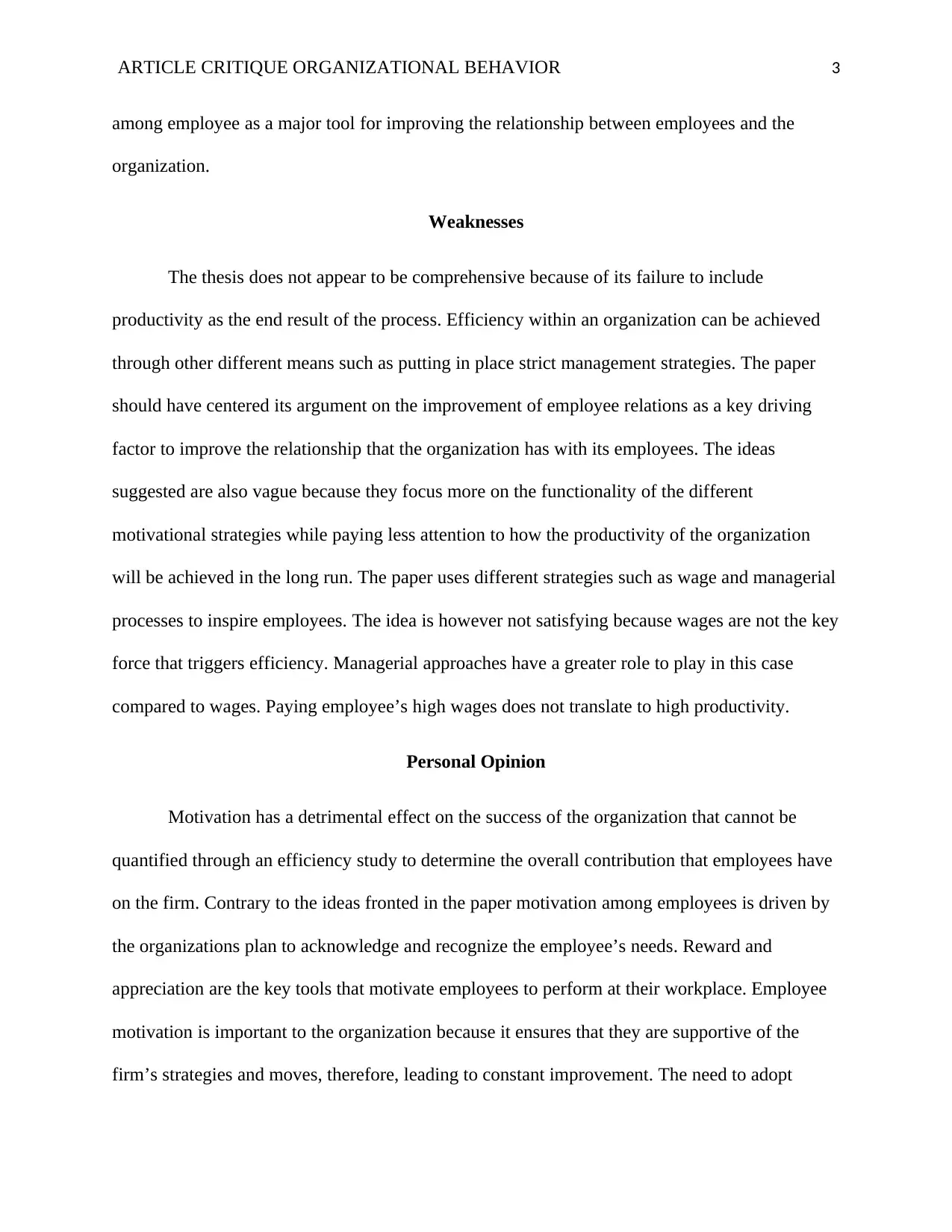
ARTICLE CRITIQUE ORGANIZATIONAL BEHAVIOR 3
among employee as a major tool for improving the relationship between employees and the
organization.
Weaknesses
The thesis does not appear to be comprehensive because of its failure to include
productivity as the end result of the process. Efficiency within an organization can be achieved
through other different means such as putting in place strict management strategies. The paper
should have centered its argument on the improvement of employee relations as a key driving
factor to improve the relationship that the organization has with its employees. The ideas
suggested are also vague because they focus more on the functionality of the different
motivational strategies while paying less attention to how the productivity of the organization
will be achieved in the long run. The paper uses different strategies such as wage and managerial
processes to inspire employees. The idea is however not satisfying because wages are not the key
force that triggers efficiency. Managerial approaches have a greater role to play in this case
compared to wages. Paying employee’s high wages does not translate to high productivity.
Personal Opinion
Motivation has a detrimental effect on the success of the organization that cannot be
quantified through an efficiency study to determine the overall contribution that employees have
on the firm. Contrary to the ideas fronted in the paper motivation among employees is driven by
the organizations plan to acknowledge and recognize the employee’s needs. Reward and
appreciation are the key tools that motivate employees to perform at their workplace. Employee
motivation is important to the organization because it ensures that they are supportive of the
firm’s strategies and moves, therefore, leading to constant improvement. The need to adopt
among employee as a major tool for improving the relationship between employees and the
organization.
Weaknesses
The thesis does not appear to be comprehensive because of its failure to include
productivity as the end result of the process. Efficiency within an organization can be achieved
through other different means such as putting in place strict management strategies. The paper
should have centered its argument on the improvement of employee relations as a key driving
factor to improve the relationship that the organization has with its employees. The ideas
suggested are also vague because they focus more on the functionality of the different
motivational strategies while paying less attention to how the productivity of the organization
will be achieved in the long run. The paper uses different strategies such as wage and managerial
processes to inspire employees. The idea is however not satisfying because wages are not the key
force that triggers efficiency. Managerial approaches have a greater role to play in this case
compared to wages. Paying employee’s high wages does not translate to high productivity.
Personal Opinion
Motivation has a detrimental effect on the success of the organization that cannot be
quantified through an efficiency study to determine the overall contribution that employees have
on the firm. Contrary to the ideas fronted in the paper motivation among employees is driven by
the organizations plan to acknowledge and recognize the employee’s needs. Reward and
appreciation are the key tools that motivate employees to perform at their workplace. Employee
motivation is important to the organization because it ensures that they are supportive of the
firm’s strategies and moves, therefore, leading to constant improvement. The need to adopt
⊘ This is a preview!⊘
Do you want full access?
Subscribe today to unlock all pages.

Trusted by 1+ million students worldwide
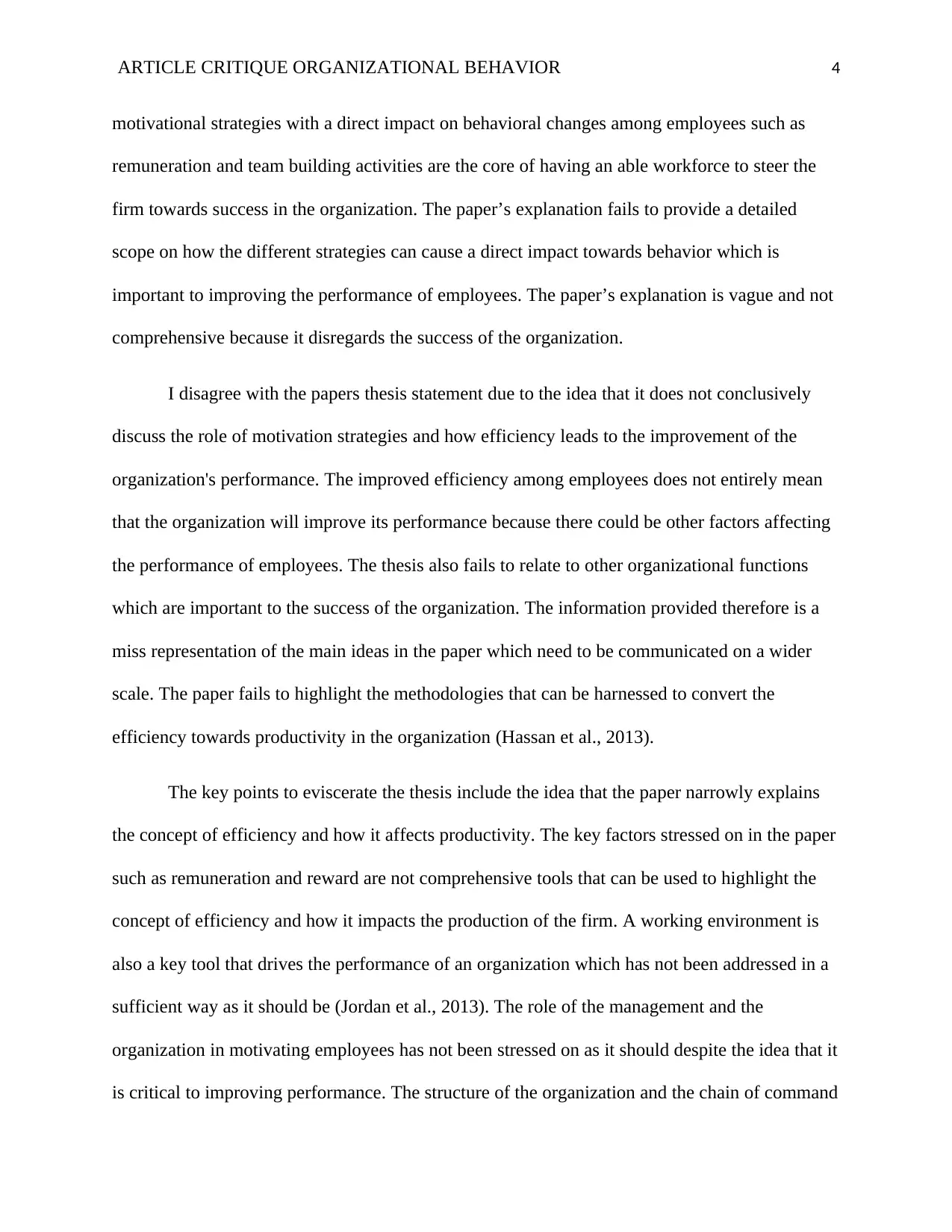
ARTICLE CRITIQUE ORGANIZATIONAL BEHAVIOR 4
motivational strategies with a direct impact on behavioral changes among employees such as
remuneration and team building activities are the core of having an able workforce to steer the
firm towards success in the organization. The paper’s explanation fails to provide a detailed
scope on how the different strategies can cause a direct impact towards behavior which is
important to improving the performance of employees. The paper’s explanation is vague and not
comprehensive because it disregards the success of the organization.
I disagree with the papers thesis statement due to the idea that it does not conclusively
discuss the role of motivation strategies and how efficiency leads to the improvement of the
organization's performance. The improved efficiency among employees does not entirely mean
that the organization will improve its performance because there could be other factors affecting
the performance of employees. The thesis also fails to relate to other organizational functions
which are important to the success of the organization. The information provided therefore is a
miss representation of the main ideas in the paper which need to be communicated on a wider
scale. The paper fails to highlight the methodologies that can be harnessed to convert the
efficiency towards productivity in the organization (Hassan et al., 2013).
The key points to eviscerate the thesis include the idea that the paper narrowly explains
the concept of efficiency and how it affects productivity. The key factors stressed on in the paper
such as remuneration and reward are not comprehensive tools that can be used to highlight the
concept of efficiency and how it impacts the production of the firm. A working environment is
also a key tool that drives the performance of an organization which has not been addressed in a
sufficient way as it should be (Jordan et al., 2013). The role of the management and the
organization in motivating employees has not been stressed on as it should despite the idea that it
is critical to improving performance. The structure of the organization and the chain of command
motivational strategies with a direct impact on behavioral changes among employees such as
remuneration and team building activities are the core of having an able workforce to steer the
firm towards success in the organization. The paper’s explanation fails to provide a detailed
scope on how the different strategies can cause a direct impact towards behavior which is
important to improving the performance of employees. The paper’s explanation is vague and not
comprehensive because it disregards the success of the organization.
I disagree with the papers thesis statement due to the idea that it does not conclusively
discuss the role of motivation strategies and how efficiency leads to the improvement of the
organization's performance. The improved efficiency among employees does not entirely mean
that the organization will improve its performance because there could be other factors affecting
the performance of employees. The thesis also fails to relate to other organizational functions
which are important to the success of the organization. The information provided therefore is a
miss representation of the main ideas in the paper which need to be communicated on a wider
scale. The paper fails to highlight the methodologies that can be harnessed to convert the
efficiency towards productivity in the organization (Hassan et al., 2013).
The key points to eviscerate the thesis include the idea that the paper narrowly explains
the concept of efficiency and how it affects productivity. The key factors stressed on in the paper
such as remuneration and reward are not comprehensive tools that can be used to highlight the
concept of efficiency and how it impacts the production of the firm. A working environment is
also a key tool that drives the performance of an organization which has not been addressed in a
sufficient way as it should be (Jordan et al., 2013). The role of the management and the
organization in motivating employees has not been stressed on as it should despite the idea that it
is critical to improving performance. The structure of the organization and the chain of command
Paraphrase This Document
Need a fresh take? Get an instant paraphrase of this document with our AI Paraphraser
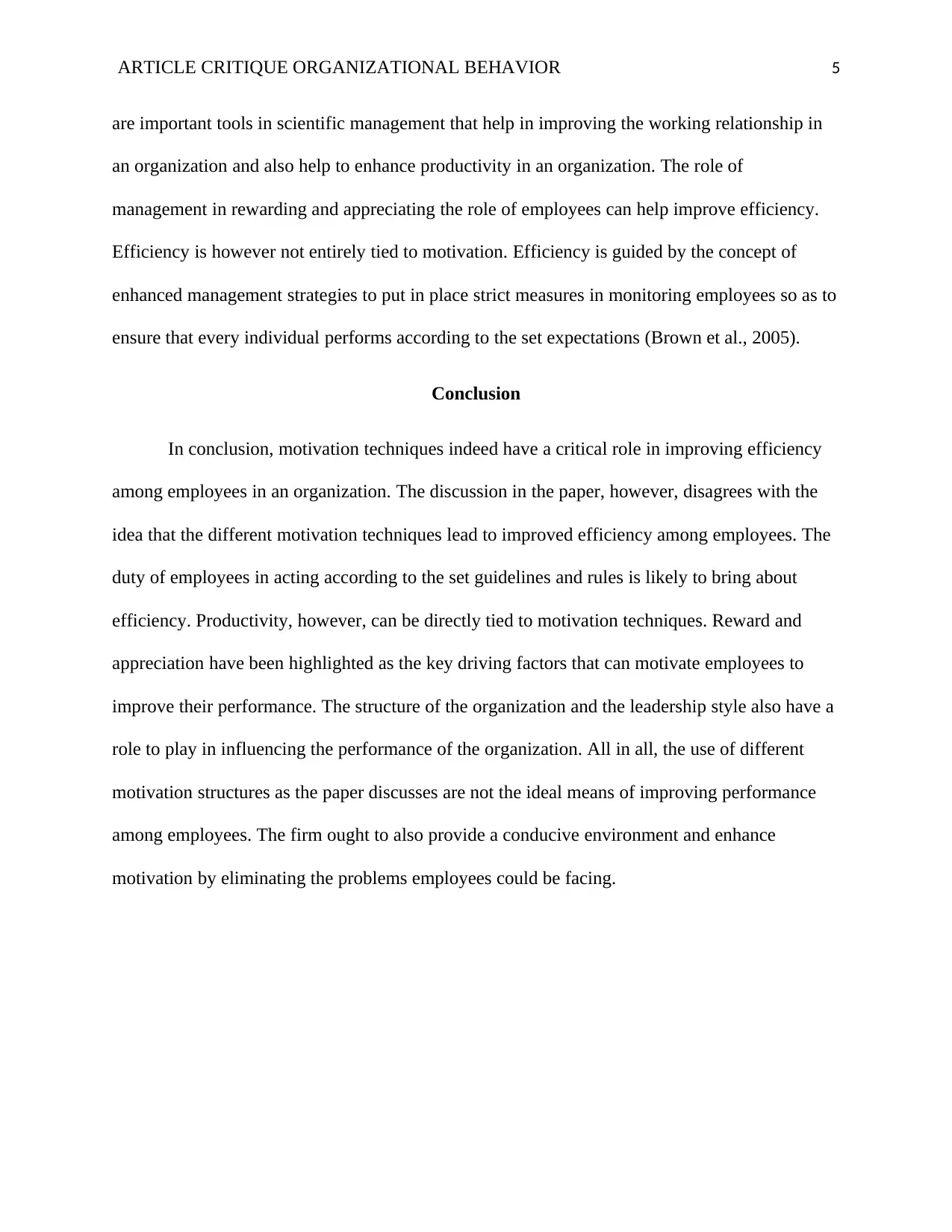
ARTICLE CRITIQUE ORGANIZATIONAL BEHAVIOR 5
are important tools in scientific management that help in improving the working relationship in
an organization and also help to enhance productivity in an organization. The role of
management in rewarding and appreciating the role of employees can help improve efficiency.
Efficiency is however not entirely tied to motivation. Efficiency is guided by the concept of
enhanced management strategies to put in place strict measures in monitoring employees so as to
ensure that every individual performs according to the set expectations (Brown et al., 2005).
Conclusion
In conclusion, motivation techniques indeed have a critical role in improving efficiency
among employees in an organization. The discussion in the paper, however, disagrees with the
idea that the different motivation techniques lead to improved efficiency among employees. The
duty of employees in acting according to the set guidelines and rules is likely to bring about
efficiency. Productivity, however, can be directly tied to motivation techniques. Reward and
appreciation have been highlighted as the key driving factors that can motivate employees to
improve their performance. The structure of the organization and the leadership style also have a
role to play in influencing the performance of the organization. All in all, the use of different
motivation structures as the paper discusses are not the ideal means of improving performance
among employees. The firm ought to also provide a conducive environment and enhance
motivation by eliminating the problems employees could be facing.
are important tools in scientific management that help in improving the working relationship in
an organization and also help to enhance productivity in an organization. The role of
management in rewarding and appreciating the role of employees can help improve efficiency.
Efficiency is however not entirely tied to motivation. Efficiency is guided by the concept of
enhanced management strategies to put in place strict measures in monitoring employees so as to
ensure that every individual performs according to the set expectations (Brown et al., 2005).
Conclusion
In conclusion, motivation techniques indeed have a critical role in improving efficiency
among employees in an organization. The discussion in the paper, however, disagrees with the
idea that the different motivation techniques lead to improved efficiency among employees. The
duty of employees in acting according to the set guidelines and rules is likely to bring about
efficiency. Productivity, however, can be directly tied to motivation techniques. Reward and
appreciation have been highlighted as the key driving factors that can motivate employees to
improve their performance. The structure of the organization and the leadership style also have a
role to play in influencing the performance of the organization. All in all, the use of different
motivation structures as the paper discusses are not the ideal means of improving performance
among employees. The firm ought to also provide a conducive environment and enhance
motivation by eliminating the problems employees could be facing.
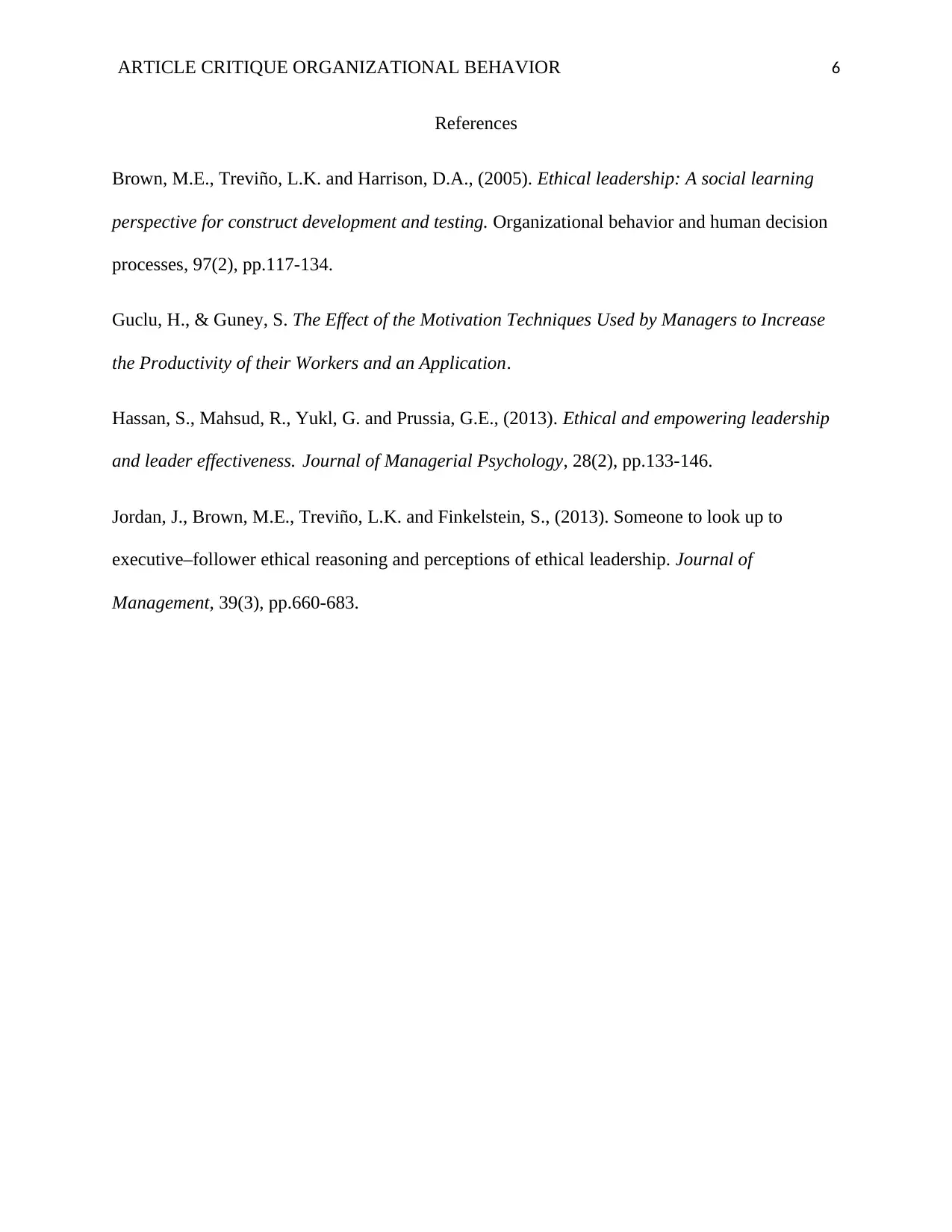
ARTICLE CRITIQUE ORGANIZATIONAL BEHAVIOR 6
References
Brown, M.E., Treviño, L.K. and Harrison, D.A., (2005). Ethical leadership: A social learning
perspective for construct development and testing. Organizational behavior and human decision
processes, 97(2), pp.117-134.
Guclu, H., & Guney, S. The Effect of the Motivation Techniques Used by Managers to Increase
the Productivity of their Workers and an Application.
Hassan, S., Mahsud, R., Yukl, G. and Prussia, G.E., (2013). Ethical and empowering leadership
and leader effectiveness. Journal of Managerial Psychology, 28(2), pp.133-146.
Jordan, J., Brown, M.E., Treviño, L.K. and Finkelstein, S., (2013). Someone to look up to
executive–follower ethical reasoning and perceptions of ethical leadership. Journal of
Management, 39(3), pp.660-683.
References
Brown, M.E., Treviño, L.K. and Harrison, D.A., (2005). Ethical leadership: A social learning
perspective for construct development and testing. Organizational behavior and human decision
processes, 97(2), pp.117-134.
Guclu, H., & Guney, S. The Effect of the Motivation Techniques Used by Managers to Increase
the Productivity of their Workers and an Application.
Hassan, S., Mahsud, R., Yukl, G. and Prussia, G.E., (2013). Ethical and empowering leadership
and leader effectiveness. Journal of Managerial Psychology, 28(2), pp.133-146.
Jordan, J., Brown, M.E., Treviño, L.K. and Finkelstein, S., (2013). Someone to look up to
executive–follower ethical reasoning and perceptions of ethical leadership. Journal of
Management, 39(3), pp.660-683.
⊘ This is a preview!⊘
Do you want full access?
Subscribe today to unlock all pages.

Trusted by 1+ million students worldwide
1 out of 6
Related Documents
Your All-in-One AI-Powered Toolkit for Academic Success.
+13062052269
info@desklib.com
Available 24*7 on WhatsApp / Email
![[object Object]](/_next/static/media/star-bottom.7253800d.svg)
Unlock your academic potential
Copyright © 2020–2025 A2Z Services. All Rights Reserved. Developed and managed by ZUCOL.





